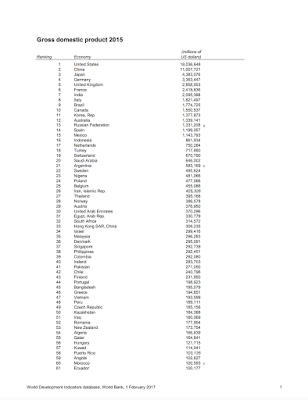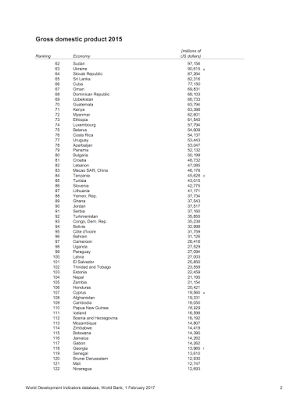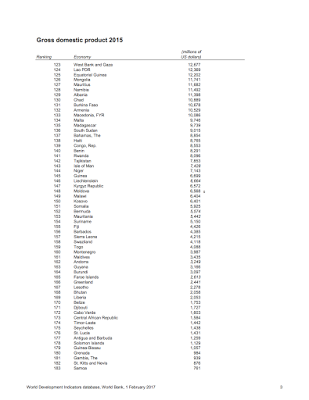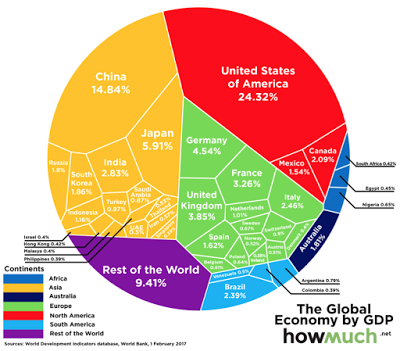
We regularly hear that China is catching up to the United States when it comes to the size of its economy, an issue that is of particular concern to the Trump Administration. While the gap may be closing, according to recent data from the World Bank, China’s GDP still lags well behind that of the United States as shown on this recent listing showing data for the 183 largest economies from 2015:
The gap of $7.029 trillion between the United States and China is still very substantial with the U.S. having 24.32 percent of the world’s $74.152 trillion economy compared to 14.84 percent for China. Formerly number two finisher, Japan, has fallen to third place and now contributes only 5.91 percent of the global GDP, well less than half of China’s contribution. It is also quite apparent how massive the output gap is between the major economies and those that contribute less.
While looking at the data is kind of boring, the folks at Howmuch.net have created this rather interesting graphic, showing the global economy in a Voronoi diagram as shown here:
The American economy is approximately the same size as the combined economies of the third through tenth largest economies combined; Japan ($4.38 trillion), Germany ($3.36 trillion), United Kingdom ($2.86 trillion), France ($2.42 trillion), India ($2.09 trillion), Italy ($1.82 trillion), Brazil ($1.77 trillion) and Canada ($1.55 trillion).
Looking at the global economy by continental region, we find the following:
Asia – 33.84 percent of global GDP
North America – 27.95 percent of global GDP
Europe – 21.37 percent of global GDP
That leaves the remaining regions including Africa, South America and Australia sharing 16.84 percent of the global economy. As well, the 40 largest economies in the world produce 90.6 percent of global economic output; this leaves more than 100 nations sharing the remaining 9.4 percent of the global economy. Even nations like India, the second-most populous nation on earth with its 1.337 billion people, contributes only 2.38 percent to the total global economy.
In closing, there is one additional way to look at the World Bank database; by national income level. Here is a breakdown of total GDP in dollars and share of global GDP for each national income level:
Low income – $394.2 billion or 0.53 percent
Lower middle income – $5.861 trillion or 7.9 percent
Upper middle income – $20.492 trillion or 27.6 percent
High income – $47.412 trillion or 63.9 percent
Despite the perception that the emerging economies of the world are taking over the global economy, the numbers clearly show that they have a long way to go before they are a significant threat to the world’s advanced economies.
Click HERE to read more.
Vote for Shikha Dhingra For Mrs South Asia Canada 2017 by liking her Facebook page.
You can publish this article on your website as long as you provide a link back to this page.






Be the first to comment